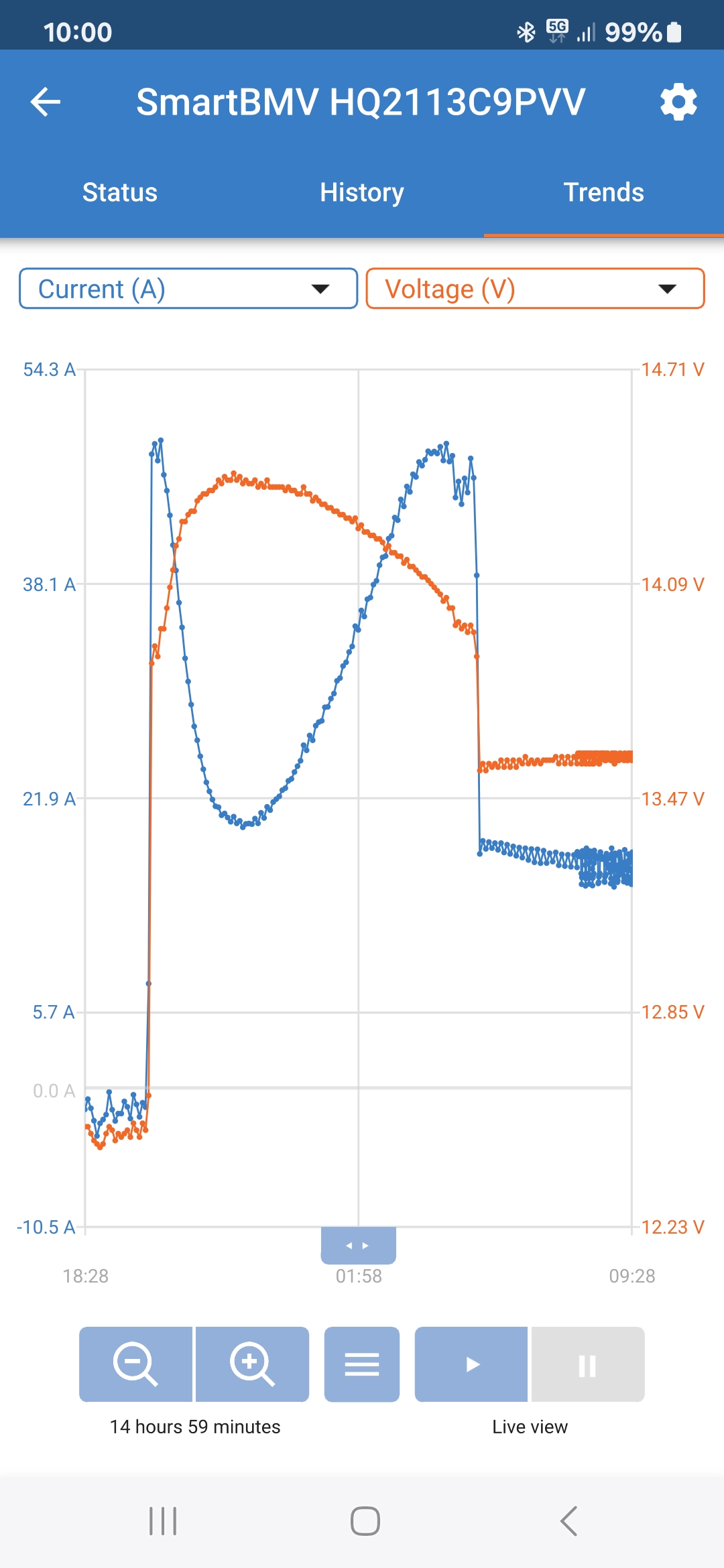Have a boat with agm batteries of 745 AH. The charger worked nice for 2 years. Last time it started to charge ok [expeced approximately 100 AH according to battery monitor). Then in the night it started to increase to charge and charged the batteries with totally 400 Ah (according to the battery monitor) and the batteries were very hot. See picture. I have ckecked all the batteries ( 6 x 6 volts) and the all seem to be ok with a voltage between 6.4 and 6.35 V. What has happened? Boken charger?
- Home
- Anonymous
- Sign in
- Create
- Spaces
- Grafana
- Node-Red
- Unsupported topics
- Questions & Answers
- Modifications
- Communauté francophone
- Deutschsprachiger Bereich
- Preguntas en Español
- Explore
- Topics
- Questions
- Ideas
- Articles
- Badges
question
Dangerous overcharging by phoenix charger
A few observations about the graph.
The voltage rose to a target voltage then dropped. As would be expected.
The amps were never above 15A. The graph scaling is a bit weird but lets say the time frame is (rounded up) 15 hours. Even though it does not remain at 15A for the time scale, at most 15a x 15 hours is 225AH charge.
Conclusion...
Something else went wrong. Not the charger.
Hazarding a guess, some plates have deformed or you have sulphation build up. Or both. Voltage is not a good indicator of battery lead acid battery health.
Thank you. You seem to be right regarding the total charge. But strange that the charger stated that it hade charged almost 400. I am aware of that the battery voltage does not say much of the capacity. I measured it for investigating if there were any broken cell in any of the batteries. The strange thing is the biphasic charge curve. Why did it start to increase charge when it normally slowly returnera to zero.
@Hansniss Do you have temperature monitoring on your batteries and temperature compensation on your charger voltage.
One explanation for what you have seen is a thermal runaway which can happen with AGM batteries if they are overcharged. Were they very hot to start with, unusually hot weather. Your batteries first went into absorption and the voltage rose to 14.4V and the current fell from 45A to 20A. However it did not fall any further and then increased.
If an AGM battery is hot during absorption the battery resistance is lower than normal. This means that the tail current at the end of absorption is higher then normal and if you use tail current to switch to float then you may not switch to float. The batteries continue to accept current but as they are full there is nowhere for the energy to go other than heating the batteries up. The resistance falls as they get hotter and the current increases creating more heat. Eventually this results in boiled swollen batteries. What I think stopped yours from extreme damage was a shut off time period for absorption.
If your batteries have not swollen then they may be OK but they may have vented some of the water so may not work as well as expected.
To try and reduce the chance of this happening with AGM you should have temperature monitoring and temperature compensation to reduce the charge voltage as temperature increases. You also need to check what exit criteria you use to stop absorption by setting say a maximum absorption time of 3 or 4 hours.
Definitely thermal runaway, as already mentioned. The real compounding issue is that you're running 3x parallel strings, and one string may have been the ringleader. It's even conceivable that one string was taking a majority of that 50A on it's own. Running Pb's at Absorb below (say) 3-4% A/Ah isn't necessary, it's time then for Float. In your case that's like ~25A of charge (@ 14.4V).
Running without Temp Comp in hot weather is dangerous. I'd drop the Abs V down to 14.2V or even less, limit Abs Time to maybe 2 hours, and if you can feel a Temp difference by touching the batts you still have a problem.
This is battery-killing stuff, and may have already caused damage. You may not notice immediately, but with 6V batts you might try disconnecting the centre connector of each string overnight to see how the individual batts hold up V in the morning (so 3 nights).
Good luck..
Related Resources
Additional resources still need to be added for this topic
question details
41 People are following this question.
